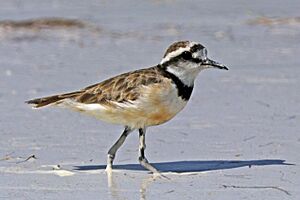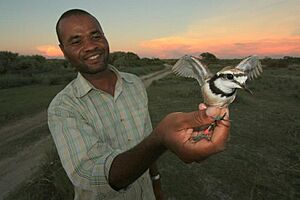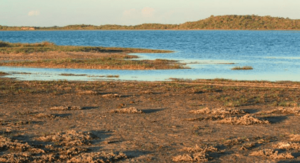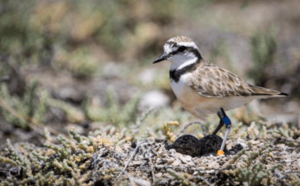Madagascar plover facts for kids
Quick facts for kids Madagascar plover |
|
|---|---|
 |
|
| Adult Madagascar plover at Tsimanampetsotsa National Park | |
| Conservation status | |
| Scientific classification | |
| Genus: |
Anarhynchus
|
| Species: |
thoracicus
|
The Madagascar plover (Anarhynchus thoracicus) is a small shorebird found only in western Madagascar. It's also known as the black-banded plover because of its markings. These birds live near lagoons, coastal grasslands, and salt marshes. They build their nests in open grassy areas and dry mudflats near salty lakes. The Madagascar plover is considered a vulnerable by the IUCN. This means its numbers are going down. This is mainly because they don't have many chicks, reproduce slowly, and struggle when their homes are destroyed.
Contents
What Does the Madagascar Plover Look Like?
The Madagascar plover is a small bird, weighing about 31 to 43 grams. That's about as much as a small candy bar! Both male and female plovers look very similar. However, females are usually a little heavier and have longer wings.
When it's breeding season, the plover looks quite striking. It has a white forehead with a black band above it, and another black band around its head. There's also a thick black band across its upper chest. The rest of its face is white. Its back and wings are greyish-brown. The feathers on its tail are lighter on the outside with dark tips and white ends. Its belly is white, with a reddish-brown lower belly. Its beak, legs, and eyes are black during this time.
Outside of the breeding season, the plover's colors are not as bright. The black markings look more brownish. Young plovers, called downy chicks, weigh about 7 grams. They have a lime-green beak that turns brownish-black at the tip. Their eyes are brown, and their legs are a dull lime-green.
How Do Madagascar Plovers Communicate?
Madagascar plovers make different sounds to talk to each other. One common call is a short 'pip' sound, repeated every 2 to 3 seconds. They also make a faster sound, like 'pipipipreeeet', repeated quickly 3 to 6 times.
Adult plovers call during the breeding season. They make sounds when joining groups, flying, or when they sense danger. If a predator is nearby, they make an alarm call that sounds like 'qui qui qui qui' while flapping their wings. Once the danger has passed, you might hear a 'tick tick' sound.
Where Do Madagascar Plovers Live?
The Madagascar plover is special because it's the only plover species found only in Madagascar. You can mostly find them along the west and south coasts of the island. Scientists believe they live in an area of about 139 square kilometers. They breed from the Mahavavy River delta in the north to Fort-Dauphin in the south-east.
These birds prefer to build their nests in places with not much plant life. This includes grasslands, coastal mudflats, salt marshes, and the edges of salty lakes and mangrove forests. They usually don't nest more than a few kilometers inland from the coast. The Madagascar plover does not migrate, meaning it stays in Madagascar all year round.
Madagascar Plover Life Cycle and Behavior
Madagascar plovers don't have many successful nests. Only about 22.9% of their nests result in chicks. If a nest fails, it takes them a long time (about 52 days) to try nesting again. They also don't re-nest very often. The areas with the most nesting plovers are Lake Tsimanampetsotsa and Marambitsy Bay.
The breeding season for these birds is long, lasting from August to June. Most eggs are laid between April and December. They usually lay two sets of eggs each season. Madagascar plovers can live for about 9 years, but some have been known to live much longer!
Nesting Habits
A Madagascar plover nest is a small dip in the ground. They usually make these nests in dry soil in grasslands, open mudflats, or near mangroves and salty lakes. They line their nests with plant material, both fresh and dry, and sometimes add small pebbles or shell pieces.
They typically lay one or two eggs, about 2 to 3 days apart. The eggs are about 33 by 24 millimeters in size. Nests are often found near plants, which helps hide them. They are usually located 2 to 50 meters away from water, as water is important for finding food. Both parents work together to build and protect the nest. They tend to stay with the same mate and nesting spot for a long time.
Both male and female plovers take turns sitting on the eggs to keep them warm, which is called incubation. Incubation starts 1 to 3 days after the last egg is laid. Sometimes, they might shade the eggs from the sun before incubation begins. They incubate the eggs for most of the day and shade them during the hottest hours. The eggs hatch about 27 to 28 days after the last egg is laid.
When the eggs are left alone, the parents cover them for protection and camouflage. If predators come near, both parents will defend the nest. It takes about 30 days for the eggs to hatch. Both parents also help care for the chicks after they hatch. Chicks can fly around 27 to 37 days after hatching. They leave the nest 1 to 5 days later.
Protecting the Madagascar Plover
The Madagascar plover is listed as Vulnerable by the IUCN. This means it's at high risk of becoming Endangered if things don't change. Some people think it might need to be listed as Endangered very soon.
Scientists believe the number of Madagascar plovers is constantly going down. This is because their wetland homes are being lost or damaged. This species is the rarest breeding plover in Madagascar. There are only about 3,100 adult birds left. Also, their nesting success is very low, and they don't reproduce fast enough to recover their numbers.
The biggest threat to the Madagascar plover is the loss of its habitat. Many of their natural wetland homes are being turned into rice paddies and shrimp farms. Since these birds live in very specific wetland areas, they are very sensitive to any damage to their homes. Sometimes, cattle can help by creating open spaces for nests. However, there's also a risk that cattle might accidentally step on birds or nests.
The Madagascar plover's natural traits, like laying only a few eggs, long incubation times, slow chick growth, and long breaks between nesting, make it harder for them to deal with changes in their environment. This makes them very sensitive to threats to their habitat.
Luckily, three nesting areas for the Madagascar plover are located inside protected national parks. These are Lake Tsimanampetsotsa, Kirindy Mitea, and Baly Bay. Some people have suggested controlling predators to help the plovers. However, this can be tricky because some of the predators might also be special, endangered, or protected species in Madagascar.





